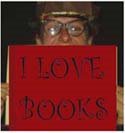 Pinkney, Brian. 1997. The Adventures of Sparrowboy. New York: Simon & Schuster.
Pinkney, Brian. 1997. The Adventures of Sparrowboy. New York: Simon & Schuster.Plot Summary
Henry is a young paperboy who reads the comics page of his daily before his route in the morning. He imagines what he would do if he became his favorite comic hero, Falconman. Henry runs into a sparrow and gets his superpowers from the ZAP! force. Flying over the neighborhood delivering papers, saving children and animals from dangerous situations, Sparrowboy is a hero on Thurber Street.
Critical Analysis
This book was written for 4 to 8 year olds and is especially great for readers interested in comics and superheros. The author plays off the comic hero's name, Falconman to create Henry's alternate superhero identity, Sparrowboy. Falconman's comic is written by the author's anagram name Barney Nipkin. Sparrowboy is a take off the Superman story. This fantasy is a common idea in many young children's imagination and Pinkney does a beautiful job of showing how fun it can be to imagine ourselves as a hero that flies through our own neighborhood doing good for others.
The artwork is the central component to the book. The layouts mimic a comic strip with dialogue boxes and meanwhile...s. The drawings are created by Pinkney's signature stratchboard style. The creator uses unique angles and sizes to emphasize the hero's view from the sky. Henry's character is a mix between a responsible job-carrying young boy and a superhero. He takes on the neighborhood bully and even wears his bicycle helmet throughout the whole book. What a true hero! This book is simple and fantastic.
Review Excerpts
"Comic book enthusiasts will find plenty of action here and feel just a little better for having curled up with this high-flying armchair adventure." - Kirkus Reviews
"Henry's heroics will win readers over instantly; he may not save the world, but before he returns to Earth, he does make his suburban neighborhood "just a little better." - John Peters, New York Public Library, School Library Journal
http://www.amazon.com/gp/product/product-description/0689835345/sr=8-1/qid=1182625574/ref=dp_proddesc_0/002-4198874-8224861?ie=UTF8&n=283155&s=books&qid=1182625574&sr=8-1
Connections
There are many juvenile picture books that feature the theme of children using flight for various reasons. The stories often involve the child's dreams and imagination. A few that may work well with Sparrowboy in a lesson include:
- Myers, Christopher. 2000. Wings. New York: Scholastic.
- Myers, Walter Dean. 1974. Fly, Jimmy, fly! Putnam.
- Ringgold, Faith. 1991. Tar beach. New York: Crown Publishers.
- This book won the author the Boston Globe/Horn Book Award
- He has won numerous other awards. For complete list go to http://biography.jrank.org/pages/155/Pinkney-Jerry-Brian-1961-J-Brian-Pinkney-Awards-Honors.html
- Brian Pinkney says, "I make pictures for the child in me. My work is actually my way of playing. That's why I think children enjoy my books; they recognize me as one of their own." http://www.eduplace.com/kids/tnc/mtai/bpinkney.html



